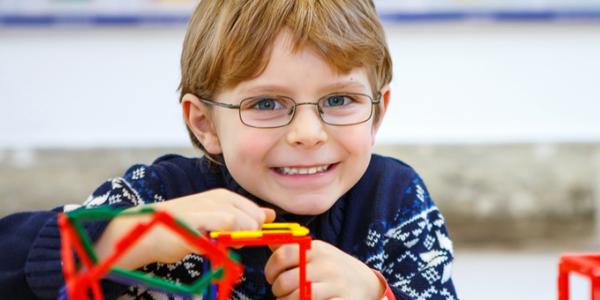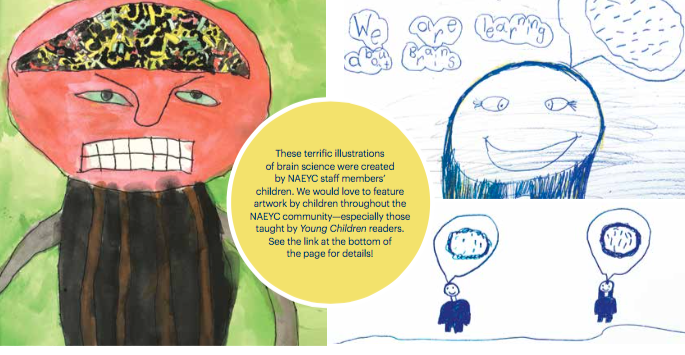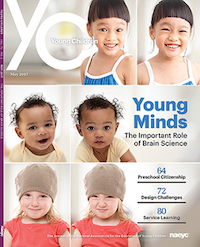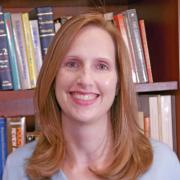Young Minds: The Important Role of Brain Science

If you’ve visited NAEYC.org lately, you’ve seen our tagline:
Promoting high-quality early learning by connecting practice, policy, and research
It’s not just a slogan, it’s our guiding principle—and it’s exemplified by the May issue of Young Children on brain science.* Whether you’re wondering how to cultivate a more joyful and effective learning environment or crafting a new policy agenda to reduce stress among needy families, the rapidly advancing field of brain science will help.
Research on how the brain develops and functions not only offers insights for educators, families, and policy makers but also provides a strong foundation for uniting our efforts. Brain science robustly reinforces what early childhood educators already know in their hearts and minds: the early years are a special time of promise and vulnerability, consistently warm relationships are as important as nutritious food, and all children have enormous potential.
This cluster opens with “Breakthrough Impacts: What Science Tells Us about Supporting Early Childhood Development” by Jack P. Shonkoff of The Center on the Developing Child at Harvard University. Based on From Best Practices to Breakthrough Impacts: A Science-Based Approach to Building a More Promising Future for Young Children and Families, this article distills a massive body of research into key takeaways. Educators and policy makers will see clearly the importance of early childhood being filled with responsive relationships and positive experiences. At the same time, they’ll grasp a hopeful message: even if a child experiences high stress, neglect, or other trauma in the early years, poor outcomes are not inevitable. Nurturing relationships—with primary caregivers, teachers, and other mentors—can foster resilience.
The next article, written by J. Ronald Lally and Peter Mangione of the Center for Child and Family Studies at WestEd, takes a deeper dive into why relationships are so critical. “Caring Relationships: The Heart of Early Brain Development” offers tips for meeting young children’s needs and building on their strengths at each stage of child development, from prenatal through age 3.

While the first two articles summarize large bodies of research on brain development, the third builds on that research foundation and offers strategies to improve the lives of children growing up in chaotic, stressful conditions. As Eric Pakulak of the University of Oregon’s Brain Development Lab and his team of researchers and educators explain in “Focusing on Families: A Two-Generation Model for Reducing Parents’ Stress and Boosting Preschoolers’ Self-Regulation and Attention,” the good news is that teachers can model strategies with families and children to improve interactions at home and in programs, and to help parents more consistently provide the warm relationships young children need.
Rounding out this cluster, two articles address hot topics for the whole early childhood field: dual language learners and play. In “The Brain Science of Bilingualism” Naja Ferjan Ramirez and Patricia Kuhl, with the Institute for Learning and Brain Sciences at the University of Washington, provide a detailed picture of how a child acquires two languages simultaneously. Importantly, the research shows that English language development is not hindered by a dual language approach and that there are substantial lifelong benefits to bilingualism. In “The Case of Brain Science and Guided Play: A Developing Story” Brenna Hassinger-Das and Kathy Hirsh-Pasek, with the Temple University Infant and Child Lab, and Roberta Michnick Golinkoff, with the Child’s Play, Learning and Development Lab at the University of Delaware, show the unique power of play to ensure that children are mentally active, socially interactive, engaged, and making meaningful connections—all of which are essential to learning.
Throughout this cluster of articles, I hope you’ll see a special opportunity to connect practice, policy, and research. While multiple forms of research are necessary to continuously improve educational programs, brain science is grabbing public attention, so this issue of Young Children could support multiple facets of your work.
 If you are a teacher, you may be inspired to help a family reduce its stress level or to share this research on early childhood brain development with your local, state, and national representatives. If you are a higher education professor, you might weave the research more intentionally into the content of your courses or write an op-ed for your local newspaper to spread the key findings throughout your community. If you are a policy maker, you could work with educators to craft tailored applications of this research. In short, opportunities abound to use brain science to create more advocates for high-quality early childhood education and to enrich young children’s lives.
If you are a teacher, you may be inspired to help a family reduce its stress level or to share this research on early childhood brain development with your local, state, and national representatives. If you are a higher education professor, you might weave the research more intentionally into the content of your courses or write an op-ed for your local newspaper to spread the key findings throughout your community. If you are a policy maker, you could work with educators to craft tailored applications of this research. In short, opportunities abound to use brain science to create more advocates for high-quality early childhood education and to enrich young children’s lives.
*Selected articles are available for free on Young Children’s website. NAEYC members may read this entire issue of Young Children online in the members only area. Not a member? For full access to Young Children, join NAEYC! Nonmembers may also receive Young Children in print by subscribing or purchasing individual issues.
We’d love to hear from you!
Send your thoughts on this issue, as well as topics you’d like to read about in future issues of Young Children, to [email protected].
Would you like to see your children’s artwork featured in these pages? For guidance on submitting print-quality photos (as well as details on permissions and licensing), see NAEYC.org/publications/forauthors/photoguidelines.
Lisa Hansel, EdD, is the editor in chief of NAEYC's peer-reviewed journal, Young Children.
